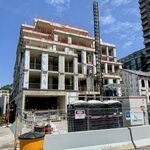Chuck
Senior Member
Toronto has graduated past the small town notions of street parking, bikes sharing road space with cars, narrow sidewalks, and two way streets. Main streets need to be converted into balanced transportation machines like the avenues of New York, and to do this I'd support the following:
- convert all streets to one way.
- synchronize signals.
- ban street parking and make back alley deliveries mandatory.
- given the increased efficiency these measures would bring, the 4th lane on ALL arterials should be converted to a dedicated 1-way bike lane, with the rest of the width going back to the sidewalks.
The model road in downtown Toronto should be 3 lanes wide, have synchronized lights, be one way, and have no parking at any time. The 4th lane should be converted into a dedicated bike lane (1m wide), with each sidewalk also being widened by 1 metre.
- convert all streets to one way.
- synchronize signals.
- ban street parking and make back alley deliveries mandatory.
- given the increased efficiency these measures would bring, the 4th lane on ALL arterials should be converted to a dedicated 1-way bike lane, with the rest of the width going back to the sidewalks.
The model road in downtown Toronto should be 3 lanes wide, have synchronized lights, be one way, and have no parking at any time. The 4th lane should be converted into a dedicated bike lane (1m wide), with each sidewalk also being widened by 1 metre.




